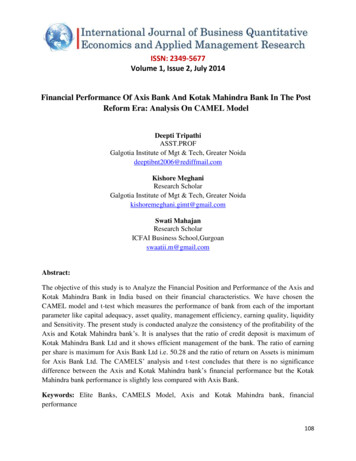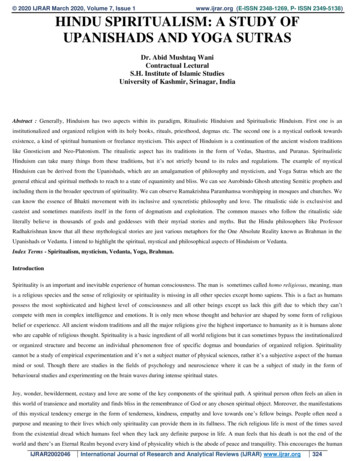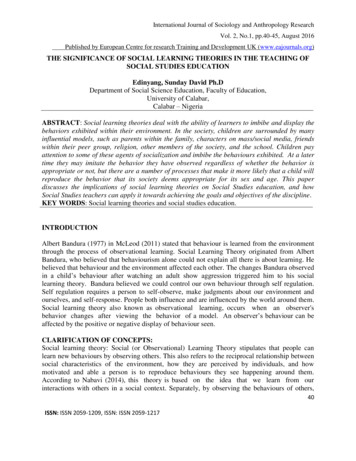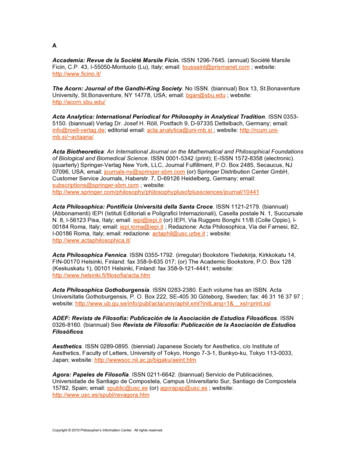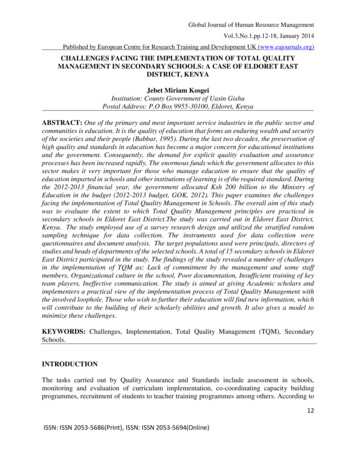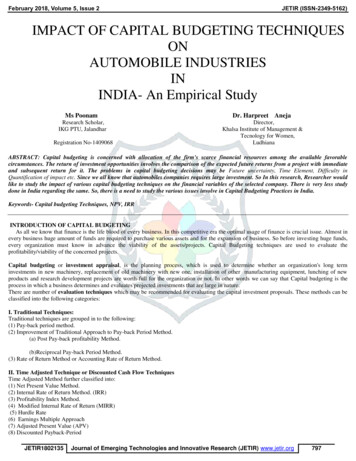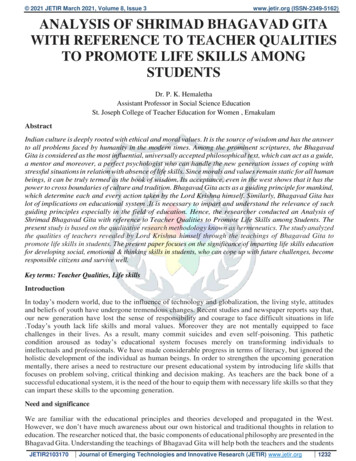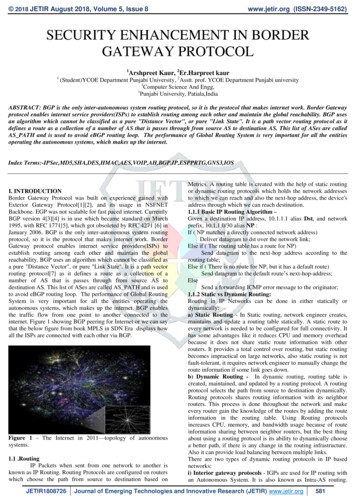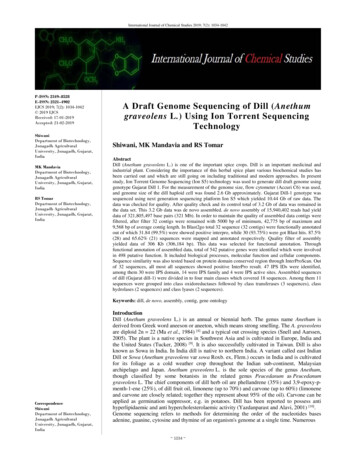
Transcription
International Journal of Chemical Studies 2019; 7(2): 1034-1042P-ISSN: 2349–8528E-ISSN: 2321–4902IJCS 2019; 7(2): 1034-1042 2019 IJCSReceived: 17-01-2019Accepted: 21-02-2019ShiwaniDepartment of Biotechnology,Junagadh AgriculturalUniversity, Junagadh, Gujarat,IndiaMK MandaviaDepartment of Biotechnology,Junagadh AgriculturalUniversity, Junagadh, Gujarat,IndiaRS TomarDepartment of Biotechnology,Junagadh AgriculturalUniversity, Junagadh, Gujarat,IndiaA Draft Genome Sequencing of Dill (Anethumgraveolens L.) Using Ion Torrent SequencingTechnologyShiwani, MK Mandavia and RS TomarAbstractDill (Anethum graveolens L.) is one of the important spice crops. Dill is an important medicinal andindustrial plant. Considering the importance of this herbal spice plant various biochemical studies hasbeen carried out and which are still going on including traditional and modern approaches. In presentstudy, Ion Torrent Genome Sequencing (Ion S5) technology was used to generate dill draft genome usinggenotype Gujarat Dill 1. For the measurement of the genome size, flow cytometer (Accuri C6) was used,and genome size of the dill haploid cell was found 2.6 Gb approximately. Gujarat Dill-1 genotype wassequenced using next generation sequencing platform Ion S5 which yielded 10.44 Gb of raw data. Thedata was checked for quality. After quality check and its control total of 3.2 Gb of data was remained inthe data set. This 3.2 Gb data was de novo assembled. de novo assembly of 15,940,402 reads had yielddata of 321,805,497 base pairs (321 Mb). In order to maintain the quality of assembled data contigs werefiltered, after filter 32 contigs were remained with 5000 bp of minimum, 42,775 bp of maximum and9,568 bp of average contig length. In Blast2go total 32 sequence (32 contigs) were functionally annotatedout of which 31.84 (99.5%) were showed positive interpro, while 30 (93.75%) were got Blast hits. 87.5%(28) and 65.62% (21) sequences were mapped and annotated respectively. Quality filter of assemblyyielded data of 306 Kb (306,184 bp). This data was selected for functional annotation. Throughfunctional annotation of assembled data, total of 542 putative genes were identified which were involvedin 498 putative function. It included biological processes, molecular function and cellular components.Sequence similarity was also tested based on protein domain conserved region through InterProScan. Outof 32 sequences, all most all sequences showed positive InterPro result. 47 IPS IDs were identified,among them 30 were IPS domain, 14 were IPS family and 4 were IPS active sites. Assembled sequencesof dill (Gujarat dill-1) were divided in to four main classes which covered 18 sequences. Among them 11sequences were grouped into class oxidoreductases followed by class transferases (3 sequences), classhydrolases (2 sequences) and class lyases (2 sequences).Keywords: dill, de novo, assembly, contig, gene ontologyCorrespondenceShiwaniDepartment of Biotechnology,Junagadh AgriculturalUniversity, Junagadh, Gujarat,IndiaIntroductionDill (Anethum graveolens L.) is an annual or biennial herb. The genus name Anethum isderived from Greek word aneeson or aneeton, which means strong smelling. The A. graveolensare diploid 2n 22 (Ma et al., 1984) [4] and a typical out crossing species (Snell and Aarssen,2005). The plant is a native species in Southwest Asia and is cultivated in Europe, India andthe United States (Tucker, 2008) [9]. It is also successfully cultivated in Taiwan. Dill is alsoknown as Sowa in India. In India dill is native to northern India. A variant called east IndianDill or Sowa (Anethum graveolens var sowa Roxb. ex, Flem.) occurs in India and is cultivatedfor its foliage as a cold weather crop throughout the Indian sub-continent, Malaysianarchipelago and Japan. Anethum graveolens L. is the sole species of the genus Anethum,though classified by some botanists in the related genus Peucedanum as Peucedanumgraveolens L. The chief components of dill herb oil are phellandrene (35%) and 3,9-epoxy-pmenth-1-ene (25%), of dill fruit oil, limonene (up to 70%) and carvone (up to 60%) (limoneneand carvone are closely related; together they represent about 95% of the oil). Carvone can beapplied as germination suppressor, e.g. in potatoes. Dill has been reported to possess antihyperlipidaemic and anti hypercholesterolaemic activity (Yazdanparast and Alavi, 2001) [10].Genome sequencing refers to methods for determining the order of the nucleotides basesadenine, guanine, cytosine and thymine of an organism's genome at a single time. Numerous 1034
International Journal of Chemical Studiestechnologies have been developed to analyze and quantify thesequencing. Any high-throughput sequencing technology canbe used for genome sequencing such as the Illumina GenomeAnalyzer, Applied Biosystems SOLiDTM, Roche 454 LifeSciences system, IonS5. Genome sequencing work will behelpful to decipher information from coding and noncodingpart of Dill. It also provides facts of genome construct itsconstituent and genic variation. The broadest application ofthe new sequencing approaches to plant species may be wholegenome sequencing (WGS) to reveal the full sequence andgenetic structure of genomes. In WGS projects such asstrawberry (Shulaev et al., 2011) [7] and wheat (Brenchley etal., 2012) [1] whole genomic DNA content was first randomlycut into fragments of different sizes. Then sequencing wascarried out and the obtained reads were assembled usingpowerful bioinformatics tools. The WGS approach can beaccomplished not only for resequencing, but also for de novoprojects.With the importance of dill as a medicinal and spices crop,this research has been challenge to discover the genesresponsible for different cellular, biological and molecularaspect through genome sequencing. Genome sequencing workwill be helpful to decipher information from coding andnoncoding part of an organism. It also provides facts ofgenome construct its constituent and genic variation.Sequencing of Anethum graveolens genome will provide amodel for characterization of metabolic pathway, involved insynthesis of bioactive compound, comparative evolutionarystudied among various Apiaceae family members & helpannotate their genome. This study provides complete map ofgenome, gene expression and metabolic network as well as itsinterplay which will be helpful to understand the biology fromgrowth to seed setting in plant and be supportive base to buildhypothesis and theory for future study. The Dill cultivarGujarat Dill 1 used for this purpose.Sequencing of sample by ION Torrent S5gDNA fragment library were prepared using Ion Shear plusenzyme mix II (as per the Ion S5 library preparationprotocol), then fragments were purified by Agencourt AMPure XP reagent (1.8X sample volume) followed by adapterligation and nick repair. Adapter ligated fragments werepurified. Size selection of library performed on 2% E-Gel.Stop the run when the 500-bp ladder band is at the top edge ofthe collection well. Fragments of the desired size are enrichedby amplifying library. Emulsion PCR was carried out togenerate multiple copies of fragments on the Ion Sphere (IPS)beads using the Ion torrent OT2 machine. Sequencing of eachIPS was carried out in Ion Torrent S5 sequencer system usingIon 530/540 chip.whether your data has any problems of which you should beaware before doing any further analysis. These tools analyzeFASTA format file to calculate different sequence statisticsand calculates the average quality score for each read andoverall average quality score for all the reads. de novogenome assembly was also carried by using CLC Version9.5.4 de novo Assembler (Merida et al., 2013) [5]. Functionalannotation was carried out by using Blast2Go software toalign the consensus sequences from the assembled contigs andthe singleton sequences (Liu et al., 2013) [3]. Identification ofputative genes was carried out using CLC software GenomicsWorkbench (CLC Genomics Workbench v9.5.4 or accordingto the manufacturer’s instructions (User manual accordingrespective company) by company (Zhou et al., 2012) [11].Data analysisRaw data quality analysis using CLC Version 9.5.4. Qualitycontrol check of raw sequence data coming from highthroughput sequencing pipelines provides a modular set ofanalyses which you can use to give a quick impression ofResults and DiscussionDetermination of genome size by flow cytometryAfter following the procedure flow cytometer gave a one pickposition. Using the following equation, calculate of C-valueand genome size.Reference pick position 389,565 pg (Figure 1)Sample pick position 1,361,465 pg (Figure 2)Reference 2C value 1.51 pg (Catharanthus roseus)Sample 2C Value 5.277 pgSample C value 2.638 pgMaterial and MethodsSample collection and DNA isolationThe seeds of Dill genotypes Gujarat Dill 1 was obtained fromSeed Spices Research Station, Sardarkrushinagar DantiwadaAgricultural University, Jagudan. Genomic DNA isolatedfrom fresh seedling tissue by following modified CTABmethod as described by Doyle and Doyle (1990) [2]. AfterDNA isolation the concentration was determined by usingPicodrop PET01 with software v2.08 (Picodrop Ltd.,Cambridge U.K). The ratio at A260/A280 was 1.85. For thegood quality and purity of genomic DNA, plant DNAextraction kit (Nucleopore DNA extraction kit) also was usedin the study.Genome size estimation by flow cytometerFor the measurement of the genome size, flow cytometer(Accuri C6) was used. The young leaves of dill were used inflow cytometry study, in which many intercalating dyes wereused to such type study. But here (PI) propidium iodide dyewas used (Nath et al., 2014) [6]. After the following allprocedure flow cytometer give a one pick position. Using thefollowing equation, calculate of C-value and genome size.Dill samples and reference material were analyzed on anEPICS Elite ESP cytometer (Beckman- Coulter, Hialeah, FL,USA) with an air-cooled argon laser at 488 nm using 20 mW.Catharanthus roseus (1.51 pg /2C) were used as internalbiological reference material. 1035
International Journal of Chemical StudiesAfter calculation sample C value 2.638 pg, here 2C mentioncause dill is a diploid plant, but genome size is estimated ashaploid one. So sample C value should multiply with 978 toget the data in Mb and that value used fixing for the allsamples or plants.Sample C value 2.638 pgSample genome size 2.638 X 978 Mb 2579.96 Mb approxFig 1: Scatter plot and pick position of Catharanthus roseus generated by accuri C6 flow cytometer (as a reference plant).Fig 2: Scatter plot and pick position of dill (Anethum graveolens) generated by accuri C6 flow cytometer.2.6 GbGenome sequencing of dill (Anethum graveolens L.)Genome sequencing of Gujarat Dill-1 genotype of dill wasdone using next generation sequencing platform Ion torrent(Ion S5). For this pure genomic DNA was extracted by usingkit, and then proceeded for the different steps to prepare thesample for the sequencing using protocol suggested by theinstrument manual. Sequencing was followed in threereplications. Genomic DNA concentration was measuredusing Qubit Fluorometer using ds DNA assay kit.Concentration of DNA was 13.2, 11.9 and 12.7 ng/µlrespectively for three different runs. Next step was DNAlibrary construction, in this step gDNA libraries wereconstructed for which Ion Shear Plus 10X Reaction Bufferwas used to fragment the genomic DNA in many fragmentsfollowed by adaptor ligation. Fragmented libraries were sizeselected using E-gel at 2% agarose. 400 bp library was elutedfrom the gel and then library was amplified, again finalamplified library concentration was checked using Qubit Fluorometer. The final library concentration was 1.14, 1.25,and 1.26 ng/µl in respect to total run. The final library wasmeasured for their concentration and the concentration ofDNA library was calculated in pmol. The concentration of theall samples was adjusted to 100 pmol by dilution withnuclease-free water and it was 4318, 4734 and 9545 pmolrespectively for all three runs. Clonal based amplification isdone using Ion one touch PCR (OT2) for every libraryfollowed by library enrichment. ISPs (sample) were loaded oneach new Ion 530 chip for sequencing.Total three runs were performed of Ion S5. In first run ofsample, total data generated was 4.34 Gb. ISPs loading was88% on the Ion 530TM chip and 13,378,296 total numbers ofreads were generated after removing of polyclonal (29%) andlow quality data (41%), and adaptor dimer with mean lengthof 325 bp. The loading of second run sample’s ISPs was 73%on the chip and total number of reads of 5,771,965 wasobtained after removing of polyclonal (19%) and low qualitydata (73%) and adapter dimer, with mean read length of 300bp. Total data generated in second run was 1.73 Gb. Secondrun was carried out by using bar codes for different samples,out of which dill was barcoded with IonXpress 002 barcodename. For dill 492,151,055 base pairs were generated andtotal reads were 220,205 and mean length of reads were 286bp. Third run was carried out in Ion 540 TM chip and total of5.6 Gb data was generated and there were 27,361,042numbers of reads with 197 bp mean read length. 1036
International Journal of Chemical StudiesData analysisTotal of 10.44 Gb raw data was generated throughsequencing. Raw sequence data were processed for qualityassessment and other processing steps using CLC workbenchv9.5.4, in which the adapter sequences were removed andtrimmed on quality bases. Total sequences and nucleotides indata sets were 16,179,010 and 3,378,117,867 respectively. Itwas found that per base sequence data was not good, somereads were having length more than 420 bp. The detail ofreads and read length given in table 1. In order to get qualityreads the data was trimmed. Total sequences in data setsbefore trimming were 16,179,010 with average read length208.8 bp. After quality filter (trimming) total sequences indata sets remain 15,940,402 with average read length 203.9bp.de novo assembly of the raw dataAfter reads filter, total sequence in data sets remains15,940,402 which yield 3.2 Gb of data. de novo assembly(draft) of dill genome was carried out by using CLC genomeworkbench v9.5.4 de novo Assembler. de novo assembly of15,940,402 reads had yield data of 321,805,497 base pairs(321 Mb). Total numbers of contigs were 555,413 in numberwith 200 bp of minimum, 10,247 bp of maximum and 579 bpof average contig length. N25, N50 and N75 measurement ofcontigs were found 1279 bp, 661 bp, and 421 bp respectivelyvia de novo assembly (Table 2). In order to maintain thequality of assembled data contigs were filtered, in which onlythose contigs who have sequence above and equal to 5000 bpwere selected for the annotation. This whole process wascarried out in CLC Genome Workbench. After filter 32contigs were remain with 5000 bp of minimum, 42,775 bp ofmaximum and 9,568 bp of average contig length (Table 3).Table 1: Before trimming /after trimming report of readsSr.No.Performedrun1.DillBefore TrimmingNumber ofAverage read lengthreads(bp)16,179,010208.8After TrimmingNumber ofAverage read lengthreads(bp)15,940,402203.9Percentage of sequence remainaftertrimmed98.53%Table 2: CLC genome work bench (v9.5.4) de novo assembler generated assembly data from genome sequencing of Gujarat Dill-1 genotype ofdillSr. No.Total sequencesNumber of Contigs1.321,805,497555,413Minimum contig lengthContig measurements200Maximumcontig lengthAverage lengthN25 N50 N7510,2475791279 661 421Table 3: CLC genome work bench (v9.5.4) Trimmed Assembly reportSr. No.Total sequencesNumber of Contigs1.306,18432Minimum contig lengthContig measurements5000Blast2go analysis of genome sequencing dataBlast 2GO is all in one tool for functional annotation of(novel) sequences and the analysis of annotation data. Total32 sequence (32 contigs) were functionally annotated out ofwhich 31.84 (99.5%) were showed positive interpro, while 30(93.75%) were got Blast hits. 87.5% (28) and 65.62% (21)sequences were mapped and annotated respectively. In datadistribution total of 32 sequences were analysed, in whichsequences analysed with different parameter like blast,mapping and annotaion. Species distribution of assembledsample had shown highest similarity with ubiuinone with 10blast hit (17.37%) followed by Marchantia polymorpha with4 blast hit (6.9%) and Nicotiana species with 3 blast hit(5.21%) (Figure 3). A maximum blast hit was approximately55 found in others species. Top hit species distribution showsthe species distribution of our sample information, where ourMaximumcontig lengthAverage length42,7759,568N25N50N7517,831 10,349 6,516sample data shows Top-Hits with majorly with Nicotianasylvestra belongs to solanaceae family which is followed sviridae and its host are molluscs. Percentsimilarity distribution of assembled sequences, out of total 32sequences, 36% sequences did not show any similarity withavailable sequences in database while 30% sequences show nmore than 75% similarity and 35% sequences shown less than75% similarity with available sequences in database. Mappingdatabase distribution of dill genome showed highest similaritywith UniprotKB followed by Saccharomyces GenomeDatabase and The Arabidopsis Information Resources (TAIR)(Figure 4). Annotation distribution of Go of dill plant genomevaries from 0-38. Among total sequences maximum werethose which were zero Go score. Some sequences werehaving 6-26 Go score. Data has been shown in (Figure 5). 1037
International Journal of Chemical StudiesFig 3: Species distribution of Blast2Go result.Fig 4: Mapping database distribution of input sequences in Blast2go analysis 1038
International Journal of Chemical StudiesFig 5: Annotation distribution of Blast2GO result.Gene ontology (go) ids and sequence distributionAfter Blast2Go analysis approximately 542 putative functionswere found from 32 input sequences, which were contributingfor 498 GO terms (biological processes (206), cellularcomponents (157) and molecular processes (135) (Figure 6).During gene ontology direct Go count were generated. Inmolecular function maximum sequences from total sequencesrespond to ubiquinone activity and protein binding showingmaximum Go count followed by Magnesium ion binding,iron-sulfur cluster binding. In biological processes maximumsequences were showing maximum Go count to ATPsynthesis followed by protein – chromophore linkage andaerbic respiration. In cellular component maximum sequenceshaving maximum Go count which respond to integralcomponent of the membrane followed by integral componentcomponent of the plasma membrane.Sequence similarity was also tested base on protein domainconserved region through InterProScan. Out of 28 sequences,all most all sequences showed positive InterPro result while 5sequences did not showed any InterPro results and 15sequences were scanned with GOs. 47 IPS IDs were identifiedfrom the sequences which were positive interproscan, amongthem 30 IPS domains were identified, 14 IPS family and 3IPS active sites were identified respectively. Details of theIPS IDs were given in supplementary Table 1(A, B, C).Table 1A: List of Interproscan Domains identifiedS.No.123456789101112131415IPS Domain(IPR027417) P-loop containing nucleosidetriphosphate hydrolase(IPR025452) Domain of unknown functionDUF4218(IPR004100) ATPase, F1/V1/A1 complex,alpha/beta subunit, N-terminal domain(IPR003593) AAA ATPase domain(IPR000194) ATPase, F1/V1/A1 complex,alpha/beta subunit, nucleotide-binding domain(IPR033732) ATP synthase, F1 complex,alpha subunit nucleotide-binding domain(IPR025312) Domain of unknown functionDUF4216(IPR024937) Domain X(IPR007120) DNA-directed RNA polymerase,subunit 2, domain 6(IPR003959) ATPase, AAA-type, core(IPR033944) Cytochrome c oxidase subunit Idomain(IPR008972) Cupredoxin(IPR007641) RNA polymerase Rpb2, domain7(IPR029014) NiFe hydrogenase-like(IPR023616) Cytochrome c oxidase-like,#Seq43SequenceDill D (single) trimmed contig 2, Dill D (single) trimmed contig 4,Dill D (single) trimmed contig 6, Dill D (single) trimmed contig 32Dill D (single) trimmed contig 28, Dill D (single) trimmed contig 27,Dill D (single) trimmed contig 52Dill D (single) trimmed contig 2, Dill D (single) trimmed contig 62Dill D (single) trimmed contig 2, Dill D (single) trimmed contig 42Dill D (single) trimmed contig 2, Dill D (single) trimmed contig 61Dill D (single) trimmed contig 61Dill D (single) trimmed contig 151Dill D (single) trimmed contig 101Dill D (single) trimmed contig 71Dill D (single) trimmed contig 41Dill D (single) trimmed contig 181Dill D (single) trimmed contig 121Dill D (single) trimmed contig 711Dill D (single) trimmed contig 25Dill D (single) trimmed contig 18 1039
International Journal of Chemical Studies161718192021222324252627282930subunit I domain(IPR007645) RNA polymerase Rpb2, domain3(IPR024034) ATPase, F1/V1 complex, betasubunit, C-terminal(IPR025724) GAG-pre-integrase domain(IPR023366) ATP synthase subunit alpha-likedomain(IPR000330) SNF2-related, N-terminaldomain(IPR007642) RNA polymerase Rpb2, domain2(IPR014001) Helicase superfamily 1/2, ATPbinding domain(IPR011759) Cytochrome C oxidase subunitII, transmembrane domain(IPR012337) Ribonuclease H-like domain(IPR000793) ATP synthase, alpha subunit, Cterminal(IPR004332) Transposase, MuDR, plant(IPR014724) RNA polymerase Rpb2, OB-fold(IPR001584) Integrase, catalytic core(IPR002541) Cytochrome c assembly protein(IPR001750) NADH: quinoneoxidoreductase/Mrp antiporter, membranesubunit1Dill D (single) trimmed contig 71Dill D (single) trimmed contig 21Dill D (single) trimmed contig 301Dill D (single) trimmed contig 61Dill D (single) trimmed contig 321Dill D (single) trimmed contig 71Dill D (single) trimmed contig 321Dill D (single) trimmed contig 1211111Dill D (single) trimmed contig 30Dill D (single) trimmed contig 6Dill D (single) trimmed contig 29Dill D (single) trimmed contig 7Dill D (single) trimmed contig 30Dill D (single) trimmed contig 201Dill D (single) trimmed contig 211Table 1B: List of Interproscan Family identifiedS.No.IPS Family#Seqs1(IPR004242) Transposon, En/Spm-like2234(IPR003918) NADH: ubiquinone oxidoreductase(IPR015712) DNA-directed RNA polymerase, subunit 2(IPR005722) ATP synthase, F1 complex, beta subunit(IPR003569) Probable cytochrome c biosynthesis protein,plants(IPR008543) Uncharacterised protein family Ycf2(IPR003567) Cytochrome c-type biogenesis protein(IPR005294) ATP synthase, F1 complex, alpha subunit(IPR000883) Cytochrome c oxidase subunit I(IPR000568) ATP synthase, F0 complex, subunit A(IPR000932) Photosystem antenna protein-like(IPR008896) Protein TIC214(IPR005869) Photosystem II CP43 reaction centre protein(IPR002092) DNA-directed RNA polymerase, phage-type111Dill D (single) trimmed contig 28,Dill D (single) trimmed contig 27Dill D (single) trimmed contig 13Dill D (single) trimmed contig 7Dill D (single) trimmed contig 21Dill D (single) trimmed contig 20111111111Dill D (single) trimmed contig 4Dill D (single) trimmed contig 20Dill D (single) trimmed contig 6Dill D (single) trimmed contig 18Dill D (single) trimmed contig 14Dill D (single) trimmed contig 9Dill D (single) trimmed contig 3Dill D (single) trimmed contig 9Dill D (single) trimmed contig 26567891011121314SequenceTable 1C: List of Interproscan Functional sites identifiedS.No.123IPS Site#Seqs(IPR020003) ATPase, alpha/beta subunit, nucleotide-bindingdomain, active site(IPR007121) RNA polymerase, beta subunit, conserved site(IPR023011) ATP synthase, F0 complex, subunit A, active site 1040 211SequenceDill D (single) trimmed contig 2,Dill D (single) trimmed contig 6Dill D (single) trimmed contig 7Dill D (single) trimmed contig 14
International Journal of Chemical StudiesFig 6: GO distribution by level (2) of top-20 for dill sequencesEnzyme class distributionAssembled sequences of dill (Gujarat dill-1) were divided into four main classes which covered 18 sequences. Amongthem 11 sequences were grouped into class oxidoreductasesfollowed by class transferases (3 sequences), class hydrolases(2 sequences) and class lyases (2 sequences) (Figure 7).Fig 7: Number of sequences and enzymes in each class.ConclusionThis information constitutes an important resource for geneticand evolutionary studies. Whole genome has a greatimportance in the field of research to understand metabolicpathways, genetic basis of disease and its relation with therisk of developing susceptibility against any adversecondition. Genomic co-dominant markers like SSR can bedeveloped from genome sequencing which become useful forthe QTL mapping programme. Whole genome also give anidea about evolution of genetic structure and function as wellas study of molecular phylogeny of individual species withthe genome of evolutionary proximate species. It alsoprovides data through which we can identify gene andfunctional elements of genome and give basis for annotationof complete plant genome. Data and information generated 1041
International Journal of Chemical Studiesafter analysis of whole genome can be used for transcriptomestudy.Reference1. Brenchley R, Spannag M, Pfeifer M, Barker GL, AmoreR, Allen AM et al. Analysis of the bread wheat genomeusing whole-genome shotgun sequencing. Nature. 2012;491:705-710.2. Doyle JJ, Doyle JL. Isolation of plant DNA from freshtissue. Focus. 1990; 12:13-15.3. Liu T, Zhu S, Tang Q, Chen P, Yu Y, Tang S. De novoassembly and characterization of transcriptome usingIllumina paired-end sequencing and identification ofCesA gene in ramie (Boehmerianivea L. Gaud). BMCGenomics. 2013; 14:125.4. Ma XH, Qin RL, Xing WB. Chromosome observations ofsome medical plants in Xinjiang. Acta PhytotaxonomicaSinica. 1984; 22:243-249.5. Merida AM, Plaza JJG, Canada A, Blanco AM, LopezMDCG, Rodrguez JM et al. De Novo assembly andfunctional annotation of the olive (Oleaeuropaea)transcriptome. DNA Research. 2013; 36:1-16.6. Nath S, Sanjaya KM, Sumita J. An improved method ofgenome size estimation by flow cytometry in fivemucilaginous species of hyacinthaceae. InternationalScoiety for Advancement of Cytometry. 2014; 85A:833840.7. Shulaev V, Sargent DJ, Crowhurst RN, Mockler TC,Folkerts O, Delcher AL et al. The genome of woodlandstrawberry (Fragariavesca). Nature genetics. 2011;43:109-116.8. Snell R, Aarssen LW. Life history traits in selfing versusoutcrossing annuals: exploring the ‘time-limitation’hypothesis for the fitness benefit of self-pollination.BioMed Central Ecology. 2005; 5:2.9. Tucker AO. ‘‘Dill’’ Grolier multimedia encyclopedia.Grolier online, 2008. http://gme.grolier.com/cgibin/article?asset id 0085590-0.10. Yazdanparast R, Alavi M. Anti hyperlipidaemic and antihypercholesterolaemic effects of Anethum graveolensleaves after the removal of furocoumarins. Cytobios.2001; 105(410):185-191.11. Zhou Y, Gao F, Liu R, Jinchao F, Hongjie L. de novosequencing and analysis of root transcriptome using 454pyrosequencing to discover putative genes associatedwith drought tolerance in Ammopiptanthus mongolicus.BMC Genomics. 2012; 13:266-279. 1042
For the measurement of the genome size, flow cytometer (Accuri C6) was used. The young leaves of dill were used in flow cytometry study, in which many intercalating dyes were used to such type study. But here (PI) propidium iodide dye was used (Nath et al., 2014) [6]. After the following all procedure flow cytometer give a one pick position .


